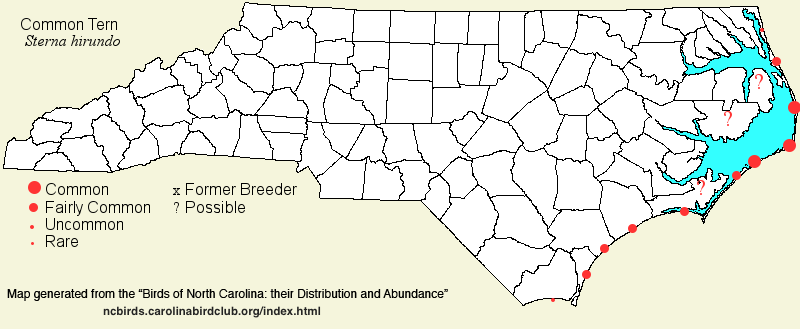 |  |
|
Common Tern - Sterna hirundo LARIDAE Members: | Search Common: Search Scientific: |
|
|
|||||||
| General Comments | Until about 20 years ago, the common name of this species (Common Tern) was quite appropriate in North Carolina. However, breeding populations of this and most other beach-nesting birds have declined considerably, as humans and their pets keep intruding onto the birds' habitat. Fortunately for the species, it nests both in North America and in Eurasia, and it breeds in far inland areas of North America as well as along the coast; thus, it is in no immediate danger of being Federally listed. In North Carolina, it has declined drastically as a breeder, and its State status in 2017 was moved from Special Concern to Endangered. Common Terns breed in the state on bare sand on barrier islands, as well as on dredge islands. They forage mostly in the ocean, at times well away from the sight of land; foraging also occurs in sounds and inlets, but it typically shuns fresh water sites when along the coast, though it may roost with other terns at coastal impoundments. As expected for an inland breeder, the species is occasionally seen in migration at inland lakes. Commons winter essentially south of the United States, and winter reports along the coast of the Carolinas are usually considered to be misidentified Forster's Terns, which can be common in winter. | ||||||
| Breeding Status | Breeder | ||||||
| NC BRC List | Definitive | ||||||
| State Status | E | ||||||
| U.S. Status | |||||||
| State Rank | S2B | ||||||
| Global Rank | G5 | ||||||
| Coastal Plain | Summer resident (breeding) and transient along the coast, and transient inland. Fairly common to at times common, but strongly declining (common prior to 1995) in the warmer months, more numerous along the northern and central coast than southward, where mostly only uncommon to fairly common (and nesting only at one or two colonies in the lower Cape Fear River). During migration, somewhat more numerous, and it can be quite common at times in fall, though numbers have declined. In the Tidewater zone, mostly rare to uncommon away from salt/brackish water. Farther inland, a rare transient, at lakes. Along the coast, mainly mid-Apr to mid-Oct, sparingly to late Nov. Nests on both small coastal islands and on barrier islands. Inland, mainly mid-Apr to late May, and mid-Aug to the end of Sep. There are a number of winter reports in the literature, but these are typically by inexperienced observers, and none are documented by photos or specimens. Thus, the species is considered to be absent in Dec, Jan, Feb, and most of Mar. Peak counts, all at Bird Shoal near Beaufort: 9,000, 22 Sep 1973; 5,000, 25 Sep 1974; 3,928, 28 Sep 1979. The peak count since 1995 is only 375 birds, except for a report of 1,000 in spring 2015. In October 2017, the legal State status of the species was upgraded from Special Concern to Endangered. | ||||||
| Piedmont | Transient. Rare in spring, and rare to at times uncommon in fall, at larger lakes and reservoirs; highest counts occur after hurricanes, when it and several other tern species can be numerous. Mainly mid-Apr to mid-May, and mid-Jul to early Oct, with a peak throughout Sep; several reports in Nov. Most remarkable for the entire state (for the late date) was one photographed at Lake Norman (Mecklenburg) on 26 Nov 2023. Peak counts: 270, Falls Lake (Durham), 5 Sep 2019 (after Hurricane Dorian); 200, Lake Norman, 15 Sep 2018 (after Hurricane Florence); 150, Jordan Lake, 6-7 Sep 1996 (after Hurricane Fran); 150, Lookout Shoals Lake, 15 Sep 1999 (after Hurricane Floyd); 135, Shelby, 22 Sep 1989 (after Hurricane Hugo). NOTE: Identification of Sterna terns, especially the separation of Common Tern from Forster's Tern, can be difficult at inland lakes. In many cases, viewing distances are over 1/2-mile, and highest counts are often during windy or rainy weather. Thus, totals of the two species must be taken with a "grain of salt", especially as both species are known to be migrants at these lakes, and overall abundances are somewhat similar. | ||||||
| Mountains | Transient. Casual in spring, and very rare in fall, at lakes in the southern mountains; about 11 records. Records are 10 May and 29 May in spring; and ? Jul (no specific date) to 15 Oct in fall. Peak counts: 100, Lake Junaluska (Haywood), 16 Sep 2018 (after Hurricane Florence); 55, Ecusta Pond (Transylvania), 16 Sep 2018 (after Hurricane Florence); 5, Hooper Lane (Henderson), 8 Sep 2004 (after Tropical Storm Frances). | ||||||
| Finding Tips |
It is still rather easily found from May into the fall along the coast, at least along the Outer Banks, especially around inlets -- however, it is no longer considered as a "gimme" along the coast in the warmer months. *** | ||||||
| Attribution | LeGrand[2025-01-30], LeGrand[2024-02-10], LeGrand[2023-03-14] | ||||||
| NC Map Map depicts all counties with a report (transient or resident) for the species. | Click on county for list of all known species. |
| NC Breeding Season Map Map depicts assumed breeding season abundance for the species. |  |